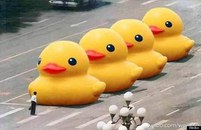the Project
Table of contents
Image Protests on Social Media - Internet Memes, Videos of Police Violence and Relations to Art
Social media platforms have become a central venue for political protests. It is images in particular that shape protests on social media. The project's theoretical interest is to determine four dimensions of image protests in their reciprocal relationships: Protests as image motifs, protests directed against images, images as instruments of protest, and images as actors that develop uncontrollable dynamics of their own within protests. By including artistic practices, the theory-building is also closely linked to issues in art studies and will be expanded into an approach that redefines the relationship between image, protest, and art in the age of social media.
This constellation is theoretically defined by the term of image protests, and will be studied in three intertwined fields of work. Sub-projects 1 and 2 are focusing on two particularly virulent examples of image protests on social media: Internet memes as political practice and videos of police violence. On another level, sub-project 3 focuses on the appropriation and reflection of these image protests in contemporary art. These focal points make it possible to analyse three very different, yet central modes of digital image protests - namely their propagandistic, documentary, and artistic dimensions – and their relations to each other.
Subproject 1: Memes as Political Image Practice
There is hardly a political event today that goes by without being processed in the form of Internet memes. In the context of political protest movements - from the New Right to Black Lives Matter, the resistance against Chinese internet censorship, or the Ukraine war - memes are used to attack the respective opponents and to mobilize affective communities. Meme practices range from conventional image-text combinations of so-called "image macros," to Photoshop montages, to "selfie protests", and photographic re-enactments. To what extent do these visual practices refer to precursors in visual art and culture? To what extent have the algorithms, affordances and communication structures of social media also led to a radical reconfiguration of political image protests?
Memes are characterised precisely by their swarm logic and are constituted by the multiplicity of interconnected units. The aim of this sub-project is to investigate the ambivalent visual resonance effects within a meme complex and highlight the uncontrollability of meme protests, which often operate on the threshold of humor and criticism and can change their political direction in the course of viral dissemination.
Subproject 2: Videos of Police Violence
The second sub-project focuses on a virulent and to this point little-noticed video corpus consisting of police or military violence against migrants. These videos take a vital position in protest movements against police arbitrariness, oppression and xenophobia. Their aesthetics are very diverse - they range from mobile phone recordings filmed by amateurs to recordings of state surveillance technologies. As an integral part of complex demonisation and securitisation practices, these videos are mostly characterised by political ambiguity.
Videos of lethal force develop an unpredictable dynamic and mobilise protest by pro-migrant groups and opponents of migration. To what extent are (state) power and resistance embedded in videos of police violence? How do different camera techniques in the border area and the algorithmic nature of the networks shape new aesthetics and dynamics of image communication?
The sub-project aims to trace the persistence of visual codes that shape the perception of the violence depicted. An analysis matrix will be created to evaluate the videos in terms of their potential to mobilize. In adding image and film aesthetic components such as blurriness, camera movement, lighting conditions, etc., this tool will also be useful to determine the emotive effects on the viewer.
Subproject 3: Artistic Appropriation and Reflection of Image Protests
The image protests investigated in the project are revisited and renegotiated in contemporary art. The third sub-project starts from the observation that the highly politicised digital visual cultures have become a central aesthetic resource for contemporary art and that the boundary between images of the media and images of art is increasingly fluid. This sub-project aims to explore this connection by looking at selected artistic positions that have emerged as a reaction to memes or videos of police violence.
While the transfer of social media images to art is obvious, the influence of artistic practices on digital visual culture is less clear. Nevertheless, the project assumes a reciprocal observational relationship between the two spheres, which will be further defined in close collaboration with the other two sub-projects. An overarching theoretical aim of this sub-project is to investigate to what extent the paradigms of digital visual cultures lead to shifts in art and how, conversely, image protests on social media are shaped by (historical) artistic approaches.
Methodology
The sheer mass of images and the metadata linked to them poses new challenges for art, as well as research in art and visual studies. One focus of our project is therefore to develop an innovative mix of methods that combines art historical methods with approaches from affect studies, while at the same time critically reflecting on digital analysis tools and exploring their use for visual culture research. We were conducting a Workshop on this topic in spring 2023 at the TU Dresden.

